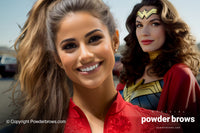3. Resolution vs. PPI in Photoshop
As an artist in the PMU field, you might have encountered various tips, tricks, and "secrets" from different trainers, often suggesting that Photoshop is unnecessary for perfecting your portfolio pictures. Frequently, these methods employ simple, quick-fix apps that may degrade the quality of your images, often without the user even realizing it. Why is this? The answer lies in understanding PPI (Pixels Per Inch) and pixel resolution - two terms often used interchangeably yet embodying distinct concepts in digital image processing.
PPI refers to the number of square pixels in one inch of a digital display – in other words, it determines the pixel density of an image. This is especially critical when printing your images, as a higher PPI will result in a more detailed printed photo. While 72 PPI is standard for web images, you'll want your images to be at least 300 PPI for a high-quality print.
Conversely, resolution represents the total number of pixels in an image (width x height). So, a 1920 x 1080 image has a total of 2,073,600 pixels. More pixels mean more information; hence, higher-resolution images are rich in detail and clarity.
Here's the critical part: the exact resolution does not mean the same quality. Two images can share the precise resolution, yet the one with a higher PPI will have a greater pixel density, thus rendering a higher-quality image. This is particularly visible when the images are scaled up. A low PPI image will lose its clarity and detail faster than a high PPI image.
To keep it simple, imagine resolution as the size of your digital canvas, while PPI is how detailed your painting on that canvas can be.
The best practice is to capture images at the highest possible resolution and maintain a high PPI to ensure quality prints and digital display. When we simplify this process using quick-fix apps, they often reduce the PPI while maintaining the resolution, leading to a loss in the quality of the image, even though the resolution appears unchanged. This is why, despite the convenience these apps offer, it's essential to comprehend the potential compromise in image quality.
So, before you abandon Photoshop due to its perceived complexity, remember: there is no substitute for the highest quality results. It's worth taking the time to learn the basics of Photoshop to safeguard your images' integrity, as these are the foundation of your professional portfolio.









